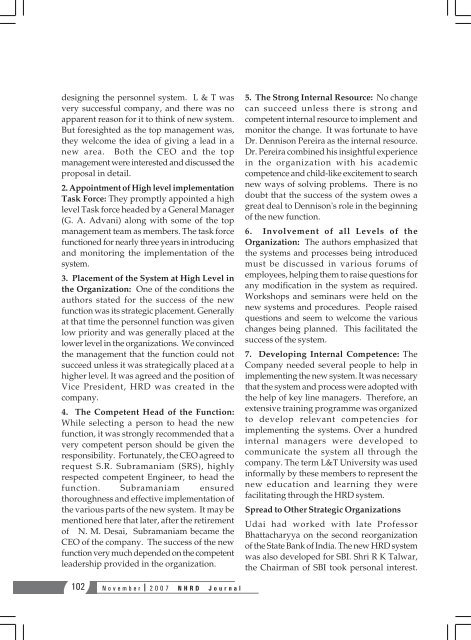NHRD Journal - National HRD Network
NHRD Journal - National HRD Network
NHRD Journal - National HRD Network
Create successful ePaper yourself
Turn your PDF publications into a flip-book with our unique Google optimized e-Paper software.
designing the personnel system. L & T was<br />
very successful company, and there was no<br />
apparent reason for it to think of new system.<br />
But foresighted as the top management was,<br />
they welcome the idea of giving a lead in a<br />
new area. Both the CEO and the top<br />
management were interested and discussed the<br />
proposal in detail.<br />
2. Appointment of High level implementation<br />
Task Force: They promptly appointed a high<br />
level Task force headed by a General Manager<br />
(G. A. Advani) along with some of the top<br />
management team as members. The task force<br />
functioned for nearly three years in introducing<br />
and monitoring the implementation of the<br />
system.<br />
3. Placement of the System at High Level in<br />
the Organization: One of the conditions the<br />
authors stated for the success of the new<br />
function was its strategic placement. Generally<br />
at that time the personnel function was given<br />
low priority and was generally placed at the<br />
lower level in the organizations. We convinced<br />
the management that the function could not<br />
succeed unless it was strategically placed at a<br />
higher level. It was agreed and the position of<br />
Vice President, <strong>HRD</strong> was created in the<br />
company.<br />
4. The Competent Head of the Function:<br />
While selecting a person to head the new<br />
function, it was strongly recommended that a<br />
very competent person should be given the<br />
responsibility. Fortunately, the CEO agreed to<br />
request S.R. Subramaniam (SRS), highly<br />
respected competent Engineer, to head the<br />
function. Subramaniam ensured<br />
thoroughness and effective implementation of<br />
the various parts of the new system. It may be<br />
mentioned here that later, after the retirement<br />
of N. M. Desai, Subramaniam became the<br />
CEO of the company. The success of the new<br />
function very much depended on the competent<br />
leadership provided in the organization.<br />
5. The Strong Internal Resource: No change<br />
can succeed unless there is strong and<br />
competent internal resource to implement and<br />
monitor the change. It was fortunate to have<br />
Dr. Dennison Pereira as the internal resource.<br />
Dr. Pereira combined his insightful experience<br />
in the organization with his academic<br />
competence and child-like excitement to search<br />
new ways of solving problems. There is no<br />
doubt that the success of the system owes a<br />
great deal to Dennison's role in the beginning<br />
of the new function.<br />
6. Involvement of all Levels of the<br />
Organization: The authors emphasized that<br />
the systems and processes being introduced<br />
must be discussed in various forums of<br />
employees, helping them to raise questions for<br />
any modification in the system as required.<br />
Workshops and seminars were held on the<br />
new systems and procedures. People raised<br />
questions and seem to welcome the various<br />
changes being planned. This facilitated the<br />
success of the system.<br />
7. Developing Internal Competence: The<br />
Company needed several people to help in<br />
implementing the new system. It was necessary<br />
that the system and process were adopted with<br />
the help of key line managers. Therefore, an<br />
extensive training programme was organized<br />
to develop relevant competencies for<br />
implementing the systems. Over a hundred<br />
internal managers were developed to<br />
communicate the system all through the<br />
company. The term L&T University was used<br />
informally by these members to represent the<br />
new education and learning they were<br />
facilitating through the <strong>HRD</strong> system.<br />
Spread to Other Strategic Organizations<br />
Udai had worked with late Professor<br />
Bhattacharyya on the second reorganization<br />
of the State Bank of India. The new <strong>HRD</strong> system<br />
was also developed for SBI. Shri R K Talwar,<br />
the Chairman of SBI took personal interest.<br />
102<br />
November 2007 <strong>N<strong>HRD</strong></strong> <strong>Journal</strong>
















